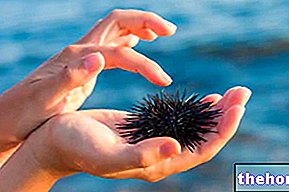In our latitudes, the jellyfish sting is usually harmless and the resulting symptoms can be mitigated with some practical measures. Less often, severe complications can arise, such as allergic reactions or anaphylactic shock, which can compromise the vital functions of the affected person in a short time. In these cases, the timeliness of intervention is essential.
inverted: the upper part (exombrella) is convex, while the lower region (subumbrella) is concave. The stinging tentacles branch off from the margin of the latter for defense and predation purposes.
In detail, the "poison" that causes the typical manifestations of the jellyfish sting is made up of a mixture of three proteins with a synergistic effect:
- Hypnotoxin: is responsible for an "anesthetic action, therefore paralyzing potential prey;
- Thalassin: after contact between the tentacles and the skin, it is the component that induces the inflammatory response in humans; in people susceptible from an immune point of view, thalassin can be allergenic;
- Congestin: it produces a paralysis of the circulatory and respiratory systems of the victims, resulting in lethality.
What triggers a Medusa Sting in humans?
In most cases, the jellyfish sting causes pain, erythema, itching, and swelling. Responsible for this reaction are the tentacles of the marine animal, in which there are cnidocysts (also known as nematocysts or nematoid cysts), that is small cellular organelles that contain the stinging substance. The latter is constituted, as anticipated, by a mixture of three proteins, with inflammatory and neurotoxic effect. The toxins contained in the cnidocysts are used by the jellyfish to defend itself and paralyze a potential prey.
The so-called jellyfish sting occurs, therefore, following contact with the tentacles: when the marine animal collides with a part of the body, the tentacles rest like a sucker. The cnidocysts are thus deposited on the skin of the victim and breaking them releases the poison. The latter is thermolabile, that is, it degrades at high temperatures.
The severity of the jellyfish sting depends on various factors, such as:
- Type of jellyfish;
- Geographical area of the accident;
- Width of the affected area;
- Time of exposure to the irritating agent and permanence in water;
- Age, size and health of the person affected (children and the elderly are more at risk of experiencing more severe reactions).
In susceptible people, the jellyfish sting can trigger anaphylactic shock, compromising vital functions in a short time, up to death.
Which jellyfish are the most dangerous?
Not all jellyfish are stinging and not all are in the same way: some are almost harmless to humans, others can cause serious damage, if not even lead to death.
Some tropical species cause anaphylactic shock more easily. Additionally, the severe pain that jellyfish sting causes can be fatal in individuals with heart problems.

Shutterstock Pelagia noctiluca
In the Mediterranean Sea, more frequently, little stinging jellyfish are observed, such as, for example, the Sea lung (Rhizostoma pulmo) or the Mediterranean Cassiopeia (Cotylorhiza tuberculata). In some periods of the year, close to the Italian coasts, however, it is possible to come across the luminous Medusa (Pelagia noctiluca), capable of very painful stings.
The Portuguese Caravel (Physalia physalis) and the sea Vespa (Chironex fleckeri, also known as cubomedusa).
(swelling of the skin), similar to those of hives. The pain associated with this irritation begins to subside after about twenty minutes, leaving room for intense itching.Jellyfish sting: what symptoms does it involve?
The jellyfish sting causes an inflammatory reaction characterized by:
- Localized redness (erythema);
- Skin reliefs (wheals);
- Vesicles and bubbles;
- Ache;
- Burning;
- Tingling and numbness
- Itching.
If the jellyfish sting involves more than 50% of the body, this symptomatology can be extremely intense and the intensity of the pain can become unbearable. Usually, the burning sensation resolves after about 10-20 minutes, but the itching remains.

It should be remembered that the effect of the jellyfish sting depends on the individual susceptibility (some people are more predisposed to develop severe reactions), the species in question, the time spent in the water and the geographical area of the accident.
Possible complications
If after the jellyfish sting, the skin reaction becomes very extensive and is associated with difficulty breathing, mental confusion, profuse sweating, pallor and disorientation, it is good to go urgently to the emergency room. The jellyfish sting can cause, in fact, anaphylactic shock and these manifestations can represent an alarm bell.
Attention! Some jellyfish are almost harmless to humans: in any case, it is good to avoid touching them. Their stinging liquid can remain on the hands, which can easily transfer it to the mouth, eyes or other delicate parts of the body, where it can still cause a inflammatory reaction.
, vomiting, profuse sweating, headache, paleness, dizziness, disorientation and breathing difficulties) it is good to seek prompt medical intervention. In some particularly sensitive people, in fact, the sting of a jellyfish can trigger an allergic reaction or, worse, anaphylactic shock. In these cases, the timeliness of intervention is essential. , that is, they are inactivated by heat. To produce this effect, however, it would be necessary to reach a temperature of about 50 ° C, risking a burn.
- Do not rub or scratch the part
After the jellyfish sting, try to resist the urge to scratch the affected area. Giving in to this instinctive reaction means breaking any residual cnidocysts, releasing further poison. Following the jellyfish sting, be careful not to touch your eyes and mouth.
- Do not rely on grandma's remedies, but apply a product based on aluminum chloride
Grandma's remedies, such as ammonia, urine, lemon, vinegar, and alcohol, could further inflame the area affected by the jellyfish sting.

To soothe the itch, it is best to use a cream or a gel based on aluminum chloride, preferably at a concentration of 5%. This product is available in pharmacies and serves to soothe itching and block the spread of toxins.
When the effects of the jellyfish sting are localized, it is better not to resort to creams containing cortisone or antihistamine, since they only come into action after about 30 minutes from application, that is when the reaction is already naturally exhausted. These active ingredients can instead work well. orally, in the case of widespread lesions or general disorders, subject to the doctor's advice.
- Beware of sun exposure
In the weeks following the jellyfish sting, the redness gives way to hyperpigmentation that could be made lasting by ultraviolet rays. Therefore, to avoid the appearance of dark skin spots, the part affected by the jellyfish sting should be covered until it is completely healed; alternatively, it is possible to resort to the application of a total filter protection (SPF 50+).


-cause-sintomi-e-cura.jpg)

























